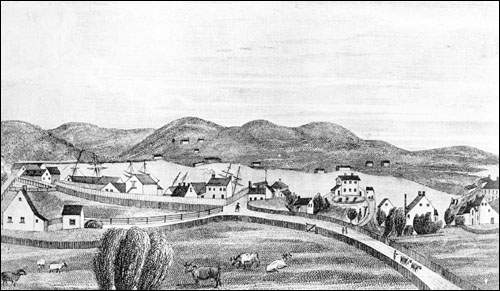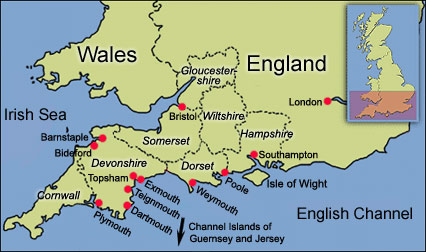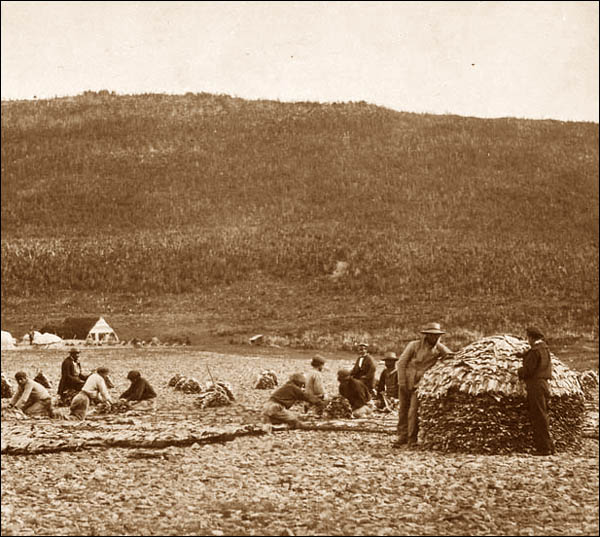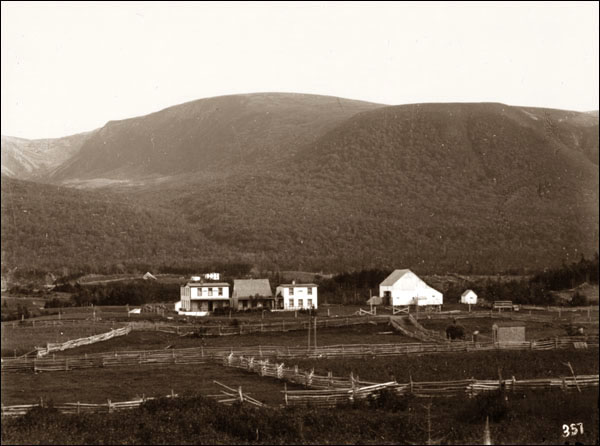Push and Pull Factors
Newfoundland and Labrador's permanent population rapidly expanded during the first half of the 19th century, largely due to an influx of English, Irish, and Scottish immigrants. Until then, the colony primarily served as a seasonal fishing station for European countries and most of its population remained on a temporary basis only. During the early 1800s, however, the migratory fishery gave way to a resident one as more and more immigrants arrived from overseas to live in coastal communities on the island or in southern Labrador.

A wide range of factors prompted immigrants to leave their homes and settle in Newfoundland and Labrador. Overpopulation in many British towns caused some residents to move elsewhere, while others wished to escape economic hardships brought on by poor harvests, job losses due to increased mechanization, the failure of local industries, and other factors.
In contrast, the early decades of the 19th century brought much economic prosperity to Newfoundland and Labrador. The Napoleonic Wars gave the colony a virtual monopoly of the salt cod trade, while the emergence of a shipbuilding industry, seal hunt, and winter trapping season helped diversity its economy and make year-round habitation possible. Well-established trade routes between the United Kingdom and Newfoundland and Labrador facilitated migration and made the latter a somewhat familiar destination to those wishing to leave their homes and settle elsewhere.
Push Factors
Push factors encourage people to leave their points of origin and settle elsewhere, while pull factors attract migrants to new areas. For example, high unemployment is a common push factor, while an abundance of jobs is an effective pull factor. Although it is impossible to know precisely why each immigrant decided to leave his or her home country to settle in Newfoundland and Labrador, it is possible to outline general push factors motivating emigration from different areas.
The period of most intense migration occurred during the first three decades of the 19th century, when Newfoundland and Labrador's population almost quadrupled from 19,000 in 1803 to 75,000 in 1836. Immigration into the country continued for the remainder of the 19th century, but not on as large a scale. Although people arrived from many places, including China, Lebanon, and Eastern Europe, most immigrants came from either southwest England or southeast Ireland.

A variety of push factors existed in England and Ireland during the early decades of the 19th century that would have motivated residents to move elsewhere. Foremost among these were economic and social stresses caused by high unemployment and expanding populations. In England, centralization and industrialization eliminated many regional jobs, particularly among the artisan class in the southwestern portion of the country. Unemployment also increased during the Napoleonic Wars (1803-1815), when trade between Britain and continental Europe collapsed under France's foreign policy. Out of work and with few local options, many tradesmen and their families emigrated to Newfoundland and Labrador.
Similar socio-economic conditions existed in Ireland. The collapse of the textile industry in the southeast and a series of poor farming seasons between 1770 and 1830 resulted in much economic hardship for members of the working class. At the same time, the country's population jumped from about four million in 1771 to seven million by 1821, placing even greater pressures on Ireland's limited jobs and resources. During the first three decades of the 19th century, between 30,000 and 35,000 people left Ireland for Newfoundland and Labrador, often to escape hunger, poverty, and overcrowded living conditions.
Pull Factors
Newfoundland and Labrador's growing economy and small resident population made it more than capable of absorbing large numbers of immigrants during the early decades of the 19th century; these same factors also made it an attractive destination for migrants wishing to escape poverty and population congestion prevalent in their points of origin.
The Napoleonic and Anglo-American wars of the early 1800s brought much economic prosperity to Newfoundland and Labrador and helped turn its inshore fishery into a resident rather than migratory industry. As French and American fisheries declined between 1804 and 1815, Newfoundland and Labrador cod became more valuable on the international market and the colony's fish exports almost doubled from 625,519 quintals to approximately 1.2 million during the same time period (1 quintal = 50.8 kilograms). European fish merchants established premises on the island and expanded into the supply trade to make groceries, equipment, clothes, and other goods available year-round to the rising number of resident families.

The growth of other industries supplemented the summer fishery and made permanent residence in Newfoundland and Labrador more attractive; these included a spring seal hunt, winter trapping season, and shipbuilding industry. Alongside making year-round occupancy possible, these industries allowed settlers to move into less-populated areas along the island's northeast coast and in southern Labrador.
The United Kingdom's well-established shipping routes with Newfoundland and Labrador also made the colony a popular destination for British migrants. Alongside sending regular shipments of goods to Newfoundland and Labrador ports, merchants in southwest England and southeast Ireland also sent workers overseas who often took up permanent residence in the colony. In addition, British vessels could not enter American ports during the Anglo-American War (1812-1814), making Newfoundland and Labrador a convenient alternative to migrants wishing to leave the Old World for the New.
Other Immigrants
It was not only people of English and Irish descent who moved to Newfoundland and Labrador during the 19th century. After 1840, many Highland Scots living in Cape Breton, Nova Scotia immigrated to Newfoundland's southwest coast. These were mostly agricultural families in search of land. Ommer (1977) argues the Scots left Cape Breton because of problems with land tenure arising from absentee landlordism and the possibility that confederation with Canada would lead to financial penalties on land not in production. Because many Scots used their property for woodcutting as well as farming, the Canadian land-use policy would have made tenure more expensive. Newfoundland and Labrador, however, had no such policy and was in reasonable travelling distance from Cape Breton. Most Scots settled in the Codroy Valley, where land was of good quality and similar to that in Cape Breton. A strong salmon fishery in the area was another pull factor.

While Highland Scots settled on the island's west coast, Lowland Scots arrived on its eastern shores during the late 18th and early 19th centuries to participate in the lucrative fish industry. Some were wealthy merchants wishing to take advantage of Newfoundland and Labrador's growing saltfish trade, while others were artisans, tradesmen, and labourers seeking employment in various merchant firms and commercial centres.
During the late 19th and early 20th centuries, small numbers of Chinese, Lebanese, and Jewish immigrants arrived at Newfoundland and Labrador, often in response to poor economic conditions in their points of origin or to religious persecution and unfriendly government regimes. After Chinese ports became open to foreign trade in the late 1800s, some of the first Chinese immigrants arrived at Newfoundland and Labrador in hopes of earning a better living. Most opened private businesses or worked in the fishery and at the Bell Island mines. Religious strife, military conscription, and poor economic conditions also prompted some Lebanese and Jewish immigrants to move to Newfoundland and Labrador during the last two decades of the 19th century; many new arrivals established private businesses or sought employment in the country's emerging mining industry or its well-established fishery.




